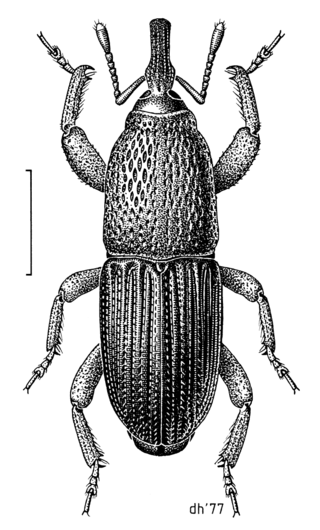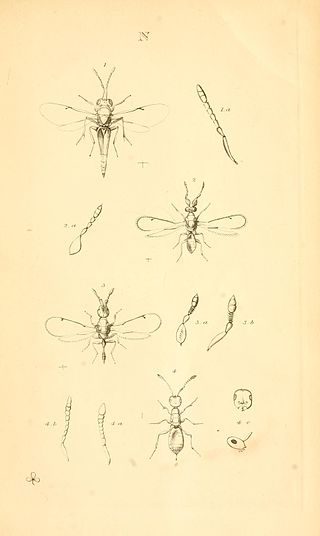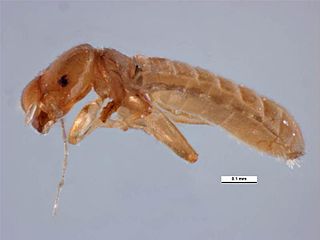
Chalcid wasps are insects within the superfamily Chalcidoidea, part of the order Hymenoptera. The superfamily contains some 22,500 known species, and an estimated total diversity of more than 500,000 species, meaning the vast majority have yet to be discovered and described. The name "chalcid" is often confused with the name "chalcidid", though the latter refers strictly to one constituent family, the Chalcididae, rather than the superfamily as a whole; accordingly, most recent publications (e.g.,) use the name "chalcidoid" when referring to members of the superfamily.

Weevils are beetles belonging to the superfamily Curculionoidea, known for their elongated snouts. They are usually small – less than 6 mm in length – and herbivorous. Approximately 97,000 species of weevils are known. They belong to several families, with most of them in the family Curculionidae. It also includes bark beetles, which while morphologically dissimilar to other weevils in lacking the distinctive snout, is a subfamily of Curculionidae. Some other beetles, although not closely related, bear the name "weevil", such as the biscuit weevil, which belongs to the family Ptinidae.

Sitophilus is a genus of weevils in the tribe Litosomini. Some species are familiar as pests of stored grain, nut, or seed. Notable pest species include the rice weevil, wheat weevil, and maize weevil.

The wheat weevil, also known as the grain weevil or granary weevil, is an insect that feeds on cereal grains, and is a common pest in many places. It can cause significant damage to harvested stored grains and may drastically decrease crop yields. The females lay many eggs and the larvae eat the inside of the grain kernels.

The almond moth or tropical warehouse moth is a small, stored-product pest. Almond moths infest flour, bran, oats, and other grains, as well as dried fruits. It belongs to the family of snout moths (Pyralidae), and more specifically to the tribe Phycitini of the huge snout moth subfamily Phycitinae. This species may be confused with the related Indian mealmoth or the Mediterranean flour moth, which are also common pantry pests in the same subfamily.

The Leucospidae are a specialized group of wasps within the superfamily Chalcidoidea, that are ectoparasitoids of aculeate wasps or bees. They are typically mimics of bees or stinging wasps, often black with yellow, red, or white markings, sometimes metallic, with a robust mesosoma and very strong sculpturing. The hind femora are often greatly enlarged, with a row of teeth or serrations along the lower margin as in Chalcididae. The wing has a longitudinal fold. The female ovipositor is sometimes short, but if not, it is recurved and lies along the dorsal side of the metasoma, a unique feature. The males are also unusual, in the fusion of many of the metasomal segments to form a capsule-like "carapace".

The Ormyridae are a small family of parasitic wasps in the superfamily Chalcidoidea. They are either parasitoids or hyperparasitoids on gall-forming insects, primarily cynipid wasps and tephritid flies. The 120 or so species are cosmopolitan, except almost entirely absent from South America.

The rice weevil is a stored product pest which attacks seeds of several crops, including wheat, rice, and maize.

Rhyzopertha is a monotypic genus of beetles in the family Bostrichidae, the false powderpost beetles. The sole species, Rhyzopertha dominica, is known commonly as the lesser grain borer, American wheat weevil, Australian wheat weevil, and stored grain borer. It is a beetle commonly found within store bought products and pest of stored cereal grains located worldwide. It is also a major pest of peanuts. The first documentation of wheat infestation by R. dominica was observed in Australia. R. dominica are usually reddish brown to dark brown in coloration, vary in sizes, elongated and cylindrical.

The maize weevil, known in the United States as the greater rice weevil, is a species of beetle in the family Curculionidae. It can be found in numerous tropical areas around the world, and in the United States, and is a major pest of maize. This species attacks both standing crops and stored cereal products, including wheat, rice, sorghum, oats, barley, rye, buckwheat, peas, and cottonseed. The maize weevil also infests other types of stored, processed cereal products such as pasta, cassava, and various coarse, milled grains. It has even been known to attack fruit while in storage, such as apples.

Theocolax is a parasitic wasp genus in the family Cerocephalidae.

Liposcelis bostrychophila is a species of booklouse in the family Liposcelididae. It is known nearly worldwide as a common pest of stored products. It is especially prevalent in cereals. In 2019 it was identified as a predator of mosquito eggs in a FAO/IAEA Insect Pest Control Laboratory which developed sterile males.

Metapelma is a parasitic wasp genus, the only genus in the family Metapelmatidae. They are parasitoids of longhorn-beetle larvae, which are wood-borers.
Lariophagus distinguendus is a idiobiont ectoparasitoid hymenopteran in the family Pteromalidae, superfamily Chalcidoidea. It parasitizes small beetle larvae concealed in seeds, as well as prepupae and pupae in their cocoons. It is used for the biological control of several beetle pests of stored products, particularly in central Europe, where it is produced commercially and distributed by at least 11 companies.
Cephalonomia tarsalis is a idiobiont ectoparasitoid hymenopteran in the family Bethylidae. Known hosts include: Oryzaephilus surinamensis, Sitophilus granarius, Sitophilus oryzae, Sitophilus zeamais, and Tribolium castaneum.

Spinetoram is an insecticidal mixture of two active neurotoxic constituents of Saccharopolyspora spinosa. It is used to control pest insects in stored grain and on domestic cats.

Mesopolobus is a genus of insects belonging to the family Pteromalidae. The genus has cosmopolitan distribution. This genus has a variety of life histories, with the majority of species being parasites of pupae.

Pelecinellidae is a small family of chalcidoid wasps, formerly treated as the subfamily Leptofoeninae within Pteromalidae. They, like many small chalcidoids, are brilliantly metallic.

Cerocephalidae is a small family of chalcid wasps, previously classified as subfamily Cerocephalinae, in the polyphyletic family Pteromalidae. Most species are parasitoids of small wood-boring beetles.

Chalcedectus is a genus of chalcid wasps, previously classified as part of the subfamily Cleonyminae, in the polyphyletic family Pteromalidae.It is the only genus in the monotypic family Chalcedectidae. Most species are parasitoids of wood-boring beetles.

















